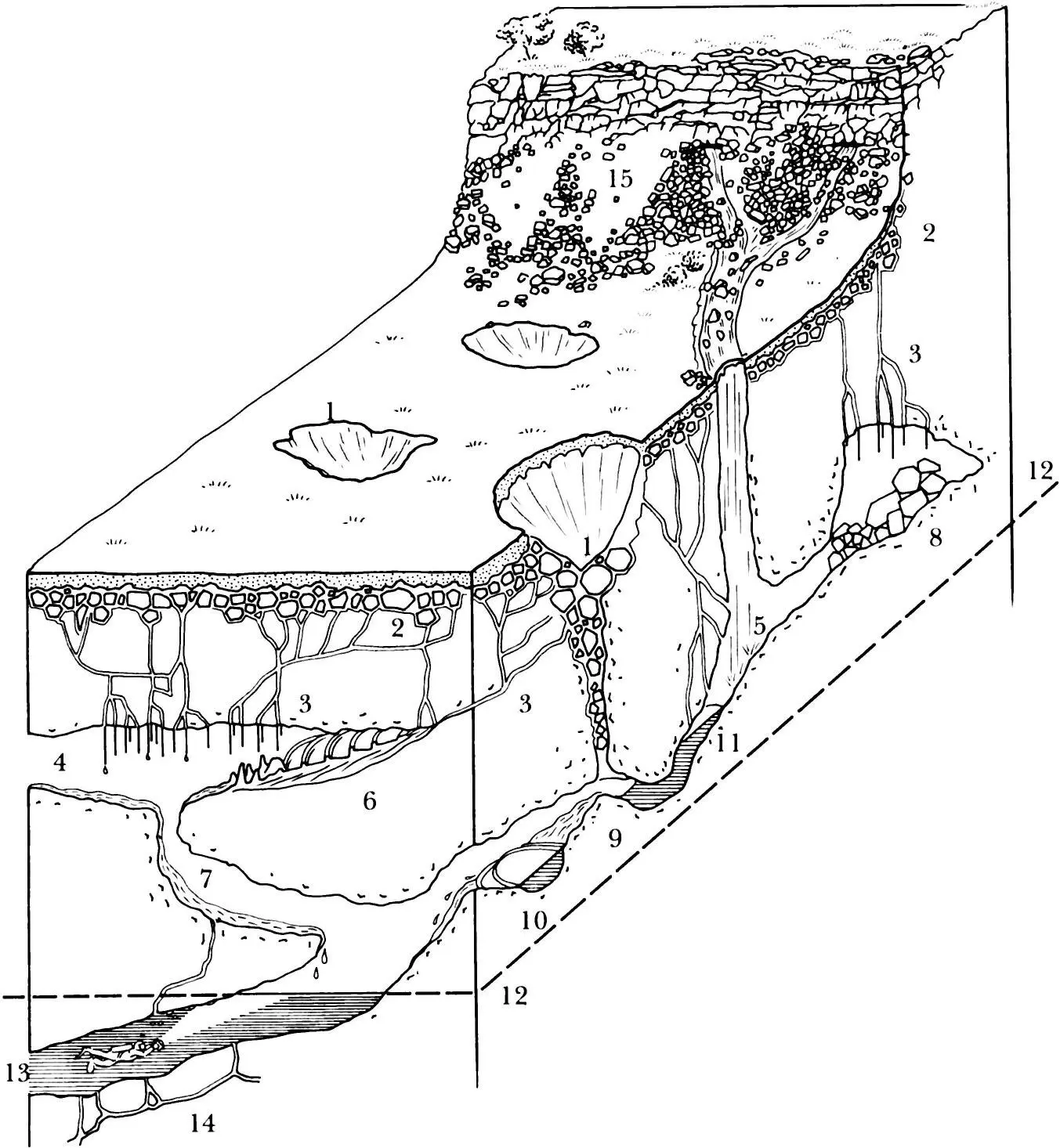Erosion of the river valleys which drain a limestone block may lower the water table within it, so that a conduit formed within the flooded phreas eventually becomes emptied of water and filled with air. One such system, GB Cave in the Mendip Hills, has received intensive study in recent years – in turn by Drs Tim Atkinson, Pete Smart and Hans Friederich of Bristol University. Their work has demonstrated the extent and importance of the system of mesocavernous conduits which overlies and feeds water and sediment into GB Cave. The conduits can be divided into three types. First there is the dense network of ‘ subcutaneous ’ cracks in the top three metres of rock beneath the soil. These have a large total volume and drain rapidly into the underlying cave, via mesocavernous collectors. They operate intermittently for up to two days following rain, but do not store a great deal of water. Two other types of inlets feed into the cave. They are small-diameter seeps, which stay full of water all the time and show little variation in flow discharge (flow being constrained by their small diameter); and vadose flows, which have higher and more variable discharges than do the seeps. Smart and Friedrich report that inlets are more frequent into shallower cave passages, and less frequent at depth, but do not give estimates of the porosity represented by these inlets, for which we have to consult Stearns on his Tennessee karst. Thus, at 10 m depth, the initially high porosity within the zone of subcutaneous flow (15%) may have fallen to about 1.5%, with a mainly downward flow via mesocavernous shafts and vadose cracks. At 30 m depth, porosity is down to 0.002%, and flow (at least in massively-bedded limestones) is increasingly confined within macrocavernous collector passages, fed by a converging network of smaller collectors of mesocavernous size. Thus, the main concentration of cave habitats (of mesocavernous dimensions) lies within the top three metres of bedrock.

Fig. 2.5 The main streamway in Poulnagollum Pot, Co. Clare – a classic vadose passage cut down through the limestone beds by an allogenic stream flowing off the eastern flank of Slieve Elva (compare with Fig. 2.1). (Chris Howes)
Phreatically-formed passages can be recognized by their characteristic circular or at least symmetrical cross-section, produced by equal corrosion of the walls, ceiling and floor (a classic example is Peak Cavern in Derbyshire). As soon as they develop an air surface, corrosion and erosion become channelled downwards and the cave stream begins to cut a trench into the floor, as is seen in the Ogof Ffynnon Ddu streamway in South Wales. This may eventually result in a canyon-shaped passage many metres deep.
As the cave matures, the enlargement of joints and bedding planes may weaken whole blocks of the ceiling and floor, resulting in their collapse. Where the cave contains an aggressive stream, such material may be removed as it falls, creating a chamber whose size is limited only by the structural strength of the overlying rock. Given enough time, the roof will eventually fail, opening the cave to the sky; if the collapsed blocks are not removed by water, the cave fills up with rubble.
The same chemical process which resulted in the removal by solution of limestone in cracks close to the surface, can go into reverse when acidified, lime-laden waters drip through cracks into an underground passage full of fresh air. As CO 2in the hanging water droplet diffuses out into the air of the cave, the resulting transformation of bicarbonate to carbonate ions forces lime to precipitate from solution. The drip falls, a rim of lime remains on the cave ceiling, and hey presto, a few thousand years later the cave is festooned with sparkling stalactites. Given an aeon more, these may completely fill up and block the passage.
Caves may also become filled with insoluble sediments from outside. This is frequently the case in Britain, where sediments enter the cave by one of three main mechanisms: large masses of unsorted clay-and-rubble have slumped into caves as a half-frozen mush during the glacial advances of the Pleistocene; sands and gravels are washed in by cave streams and dumped as the waters slow down in more gently graded stretches of cave; and fine mud is often trickled downwards by percolation water until it completely fills passages right up to the roof.
The worst ravages of collapse and sedimentation may be reversed by a little-known bio-chemical phenomenon known as ‘digging’. First noted in Mendip caves, it appears to be caused by large sweaty men in overalls, armed with plastic buckets, and generally takes place at weekends in the pursuit of new explorations and discoveries underground. The chemical component of the process consists in a sparing application of ‘Dr Nobel’s Linctus’ to otherwise immovable blockages, with sometimes impressive results. We shall consider the conservation implications of digging and blasting in caves in a later chapter.
Types of cave habitat
In the previous section, we traced the process of cave formation in limestones by the gradual chemical enlargement of bedding cracks and joints, their subsequent drainage, further enlargement, collapse and infilling by sediment, breakdown and speleothems. In the course of this ‘life cycle’, limestone caves present a series of distinct habitats which are each exploited by a characteristic biota.
In recent years, similar biotas have been found in equivalent habitats in a wide range of other rocks (lava, gypsum, mudstone, shale, chert, breccia, tuff, rhyolite, diorite, quartzitic sandstone, etc) and sediments. This has led to a plethora of exotic technical terms in the literature – it seems that any biologist who finds a new habitat wants to give it an impressive, polysllabic label, an urge doubtless born of years of grappling with latin species names. My favourite examples include ‘parafluvial nappes’ (as worn by water-babies?), ‘hypotelminorheic biotope’ and ‘the petrimadicolous biocoenose’ (etymologically-inclined readers may enjoy trying to sort out these little beauties). In the section which follows, I have attempted to keep things simple by stressing the the similarities between habitats, rather than the differences between them.

Fig. 2.6 Cave habitats and structural features in a limestone upland.
1. Dolines or shakeholes 2. SUC or subcutaneous zone 3. Mesocavernous seeps and conduits 4. Air-filled macrocavern or dry cave passage 5. Vadose macrocavern or wet cave passage 6. Rimstone gour pools 7. Cave sediment 8. Breakdown blocks 9,10. Riffle and pool in cave system 11. Perched siphon or sump 12. Water table 13. Water-filled macrocavern or sump in the phreas below water table 14. Water-filled mesocaverns in the phreas 15. Talus, below a scar or limestone cliff.
Air-filled macrocaverns (dry caves)
The longest, biggest and, by any criteria, the best macrocaverns are those developed in limestone. The world’s longest cave is the Mammoth Cave system in Kentucky at over 540 kilometres, while the deepest is the Réseau Jean Bernard in the French Pyrenees at over 1600 m deep. Our longest cave, the Ease Gill system in Yorkshire, 70 km long, can manage only 15th place in the world ratings. The ages of caves vary considerably. Recent estimates suggest that certain limestone cave passages in North America could have formed 10 million years ago, while some tropical limestone caves are estimated to be only around 100,000 years old.
Читать дальше














